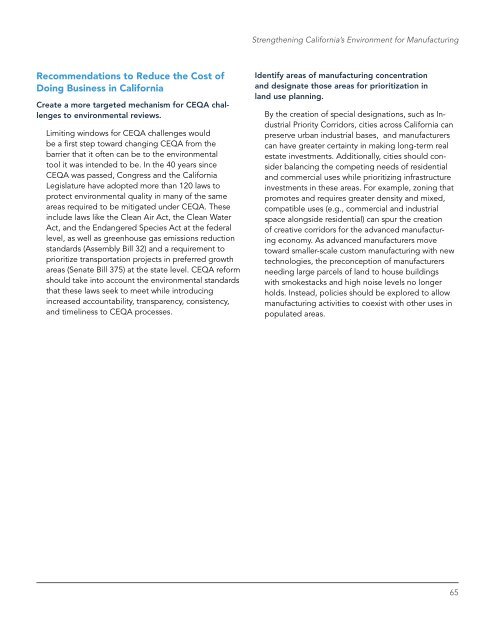Reinventing Manufacturing
eayWVRd
eayWVRd
Create successful ePaper yourself
Turn your PDF publications into a flip-book with our unique Google optimized e-Paper software.
Strengthening California’s Environment for <strong>Manufacturing</strong><br />
Recommendations to Reduce the Cost of<br />
Doing Business in California<br />
Create a more targeted mechanism for CEQA challenges<br />
to environmental reviews.<br />
Limiting windows for CEQA challenges would<br />
be a first step toward changing CEQA from the<br />
barrier that it often can be to the environmental<br />
tool it was intended to be. In the 40 years since<br />
CEQA was passed, Congress and the California<br />
Legislature have adopted more than 120 laws to<br />
protect environmental quality in many of the same<br />
areas required to be mitigated under CEQA. These<br />
include laws like the Clean Air Act, the Clean Water<br />
Act, and the Endangered Species Act at the federal<br />
level, as well as greenhouse gas emissions reduction<br />
standards (Assembly Bill 32) and a requirement to<br />
prioritize transportation projects in preferred growth<br />
areas (Senate Bill 375) at the state level. CEQA reform<br />
should take into account the environmental standards<br />
that these laws seek to meet while introducing<br />
increased accountability, transparency, consistency,<br />
and timeliness to CEQA processes.<br />
Identify areas of manufacturing concentration<br />
and designate those areas for prioritization in<br />
land use planning.<br />
By the creation of special designations, such as Industrial<br />
Priority Corridors, cities across California can<br />
preserve urban industrial bases, and manufacturers<br />
can have greater certainty in making long-term real<br />
estate investments. Additionally, cities should consider<br />
balancing the competing needs of residential<br />
and commercial uses while prioritizing infrastructure<br />
investments in these areas. For example, zoning that<br />
promotes and requires greater density and mixed,<br />
compatible uses (e.g., commercial and industrial<br />
space alongside residential) can spur the creation<br />
of creative corridors for the advanced manufacturing<br />
economy. As advanced manufacturers move<br />
toward smaller-scale custom manufacturing with new<br />
technologies, the preconception of manufacturers<br />
needing large parcels of land to house buildings<br />
with smokestacks and high noise levels no longer<br />
holds. Instead, policies should be explored to allow<br />
manufacturing activities to coexist with other uses in<br />
populated areas.<br />
65


